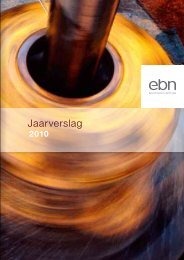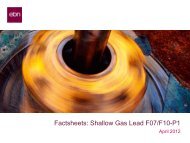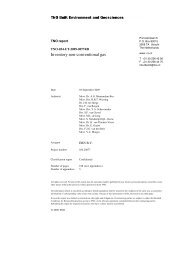Notional Field Development Final Report - EBN
Notional Field Development Final Report - EBN
Notional Field Development Final Report - EBN
Create successful ePaper yourself
Turn your PDF publications into a flip-book with our unique Google optimized e-Paper software.
<strong>EBN</strong> <strong>Notional</strong> <strong>Field</strong> <strong>Development</strong> Plan<br />
3.3.2.3 Fracture Complexity<br />
Fracture complexity was approximated by the use of a dual porosity model. Because the dual porosity<br />
model is fundamentally different from the homogenous (single porosity) case, an equivalent fracture<br />
permeability that mimics the homogenous case (without additional complexity) must be established.<br />
This was found to be .001mD rather than .0001mD used in the single porosity case. Fracture complexity<br />
is then introduced as an improved fracture permeability area around the hydraulic fracture with a<br />
permeability value of 0.15mD.<br />
Figure 3-35, Comparison of Dual Porosity Model (Unmodified & Modified) vs. the Base Case displays an<br />
approximately 53% loss in production using the base case parameters in a dual porosity model. By<br />
incorporating a fracture permeability of .001 mD we are able to closely imitate the single porosity<br />
homogeneous case. By reproducing the same cumulative production with a dual porosity model we can<br />
now accurately forecast how fracture complexity will affect our production.<br />
250,000<br />
3100m Posidonia<br />
Cumulative Gas (MCM) vs. Time (years)<br />
200,000<br />
203419 MCM<br />
BASE CASE: 1500m<br />
Lateral - 22 Frac Stages<br />
Cum Gas (MCM)<br />
150,000<br />
100,000<br />
200817 MCM<br />
CASE B: Dual Porosity<br />
Equivalent Modified<br />
Base Case: Dual Porosity<br />
Unmodified<br />
95424 MCM<br />
50,000<br />
0<br />
1 2 3 4 5 6 7 8 9 10 11 12 13 14 15<br />
Time (years)<br />
Figure 3-35, Comparison of Dual Porosity Model (Unmodified & Modified) vs. the Base Case<br />
The Figure 3-36, Shale Gas Modeling, describes the different types of hydraulic fracture complexity we<br />
use in single well reservoir simulation.<br />
© 2011 Halliburton All Rights Reserved<br />
54







